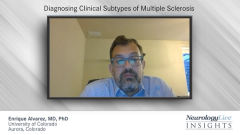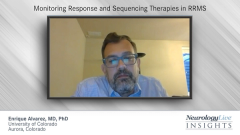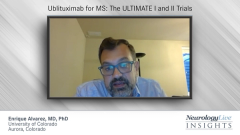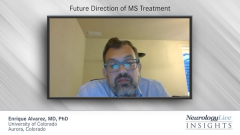
Selecting a High-Efficacy Therapy for RRMS
Two experts in multiple sclerosis share insights on the shared decision-making process when selecting a high efficacy therapy and emphasize the importance of disease characteristics and patient preference.
Episodes in this series

Lawrence Steinman, MD: The high efficacy therapies are basically in 2 different baskets. One is high efficacy oral therapies. There’s a whole group of orally available medications that reduce the relapse rate strongly and are also able to reduce the progression of disability. They’re generally called the S1P [sphingosine-1-phosphate] inhibitors. They’re oral drugs. Then you have a group of drugs that can be in that category, like cladribine, that are somewhat stronger. Then you have the biologics, the monoclonal antibodies. One of the monoclonal antibodies is natalizumab. It blocks the homing of immune cells into the brain and spinal cord. It’s exceptionally effective. It has a risk factor called PML [progressive multifocal leukoencephalopathy], which is another terrible complication, but this risk is mitigated by a simple blood test that tells you whether you are at risk or at essentially no risk for this complication. That blood test is an antibody test against the virus that causes the complication.
Then you have infusible or injectable versions of a monoclonal antibody-targeting molecule called CD20. That’s also highly efficacious. The medications are generally given every 6 months by infusion. One of them is given monthly by subcutaneous injection. Those categories of drugs, natalizumab and the anti-CD20s, have the highest efficacy. There are a number of different medications to choose from and factors to consider, including whether the person is very averse to getting an injection either by the intravenous route or the subcutaneous route. There are examples of oral drugs that are still highly efficacious, but don’t require infusion, that you can choose from. The speed of infusion may be important. The cost of these medications is important to the health care provider and an individual with various types of insurance plans.
When I go into the room with an individual, I like to give the high efficacy drugs and try to size up what their various anxieties are, whether they’re worried about an injectable or an oral, or whether they’re worried about some of the potential adverse effects. All of the drugs have adverse effects that can be followed. The risks can largely be mitigated by observation, and in the case of 1 of the drugs I mentioned, a simple lab test. It’s a matter of what I think the patient will be most comfortable with.
Generally, my style is to strongly suggest one or the other. If I detect pushback, I’ll go to a plan B with another type of drug. But generally, when a patient, and even us doctors, go to the doctor, we’re going there for advice, not for a menu of different things that they could do. When I go to a restaurant, I like to order what I want. When I go to the doctor, I like to hear what the doctor wants. Leading somebody to what you think is the correct decision is what I would call plan A. Upon encountering pushback, of course, I’ll go to plan B for the best of reasons. It would be akin to, if I like something on a menu and they say, “That’s no longer available, we just cooked our last fish of the day,” then I go to plan B. That’s simplistically how I do it.
Enrique Alvarez, MD, PhD: As we start to have more specific discussions with patients, here are some of the things I go through with them in the clinic. After having a discussion about MS [multiple sclerosis] and seeing how they’re handling that, if they’re ready to start making a decision, here are things to take into account. Often, by the time they make it to an academic center, they might’ve had some preliminary reads on different types of options. They might’ve had discussions. They might know somebody with MS and talk to them about treatments. Trying to gauge how knowledgeable they are about the different options is important.
There’s a fine balance between going through 25-plus different options and trying to simplify it by groups. As you home down on things, you can get into more specifics. Touching base on highlights becomes important. It becomes important to not just present 1 or 2 drugs, and recognize that you do need to know what the options are to have these discussions. As you start to have these discussions, what are the things to actually talk about? It’s always important to talk about efficacy. If you start a therapy, what are the chances that you’re going to do well with it and won’t need to do any switching of therapies and things like that? This is the first thing that patients really want to hear. As you start to talk about these groups, I usually break them out into low, medium, and high efficacy therapies because it helps categorize them a little. It’s really a spectrum, so it’s not eliminating them, but having some framework that you can present.
Within those groups, I start to talk a little about specifics and I gauge their interest. You want to have a sense for whether they are willing to do injections. Are they liking the option of being able to skip dealing with an infusion center, and just getting the medicine delivered to their house and being able to do it? If they travel a lot, are they going to be able to travel with their medicine easily? Can they fit their treatments in between travel and those kinds of things? That becomes important. Adding a discussion around tolerability also becomes important. For example, I use some dimethyl fumarate or some of the other fumarates. You have to have a discussion and ask, “If you develop some GI [gastrointestinal] issues and have diarrhea, do you work from home? Maybe it’s an easier way to deal with that?” The answer for that in the last year has obviously become a little more common with people working from home due to COVID-19. But if they already have GI issues from things like Crohn disease or gluten intolerability, their chances of wanting to do something that might affect their GI issues is going to be a hard no. Then you know that’s not an option, and it becomes important to think about other treatment options.
There are patients who when you see them in the clinic, you may make certain decisions for them and say, “These are not options for you.” Sometimes there are easy decisions. If you see a patient and they have 10 active lesions after the first attack and they’re already in a wheelchair, you want something that works fast, and you’re going to eliminate a lot of options. A lot of times, patients, especially with mild disease, might have a lot of different options. Going through the options that are realistic for you is important. The idea of the shared decision-making is very important. The patient’s adherence to a medication is super important. If they don’t take their medicine, you can almost guarantee what the efficacy is going to be. There’s not going to be any huge benefit in doing those therapies. We also have to gauge patients for whether they’re going to stick with the protocol for follow-ups. If you have medication such as natalizumab or fingolimod and a concern for rebound, and the patients start taking their medicines and are great at it for 6 months or a year but then they drop out, are you putting them at risk for a rebound of disease activity afterward and things like that? Those things are also important in deciding on treatment options.
Transcript Edited for Clarity
Newsletter
Keep your finger on the pulse of neurology—subscribe to NeurologyLive for expert interviews, new data, and breakthrough treatment updates.























